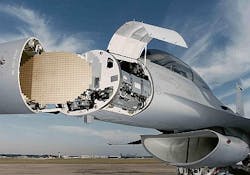Air Force eyes passive radar surveillance with initiative on wideband phased array antennas
WRIGHT-PATTERSON AFB, Ohio, 28 Oct. 2012. U.S. Air Force researchers are reaching out to industry to find companies able to design revolutionary new wideband dual polarized phased array radar antenna technologies that may lead to covert passive radar surveillance for ground sites and aircraft.
The RF Systems Branch of the Air Force Research Laboratory's Sensors Directorate at Wright-Patterson Air Force Base, Ohio, has released a request for information (RFI RFI-PKS-0001-2012) for the Phased Array Antenna for Passive RF Sensing program.
This initiative seeks to develop new radar antennas for ground and airborne demonstrations of in a passive RF testbed that will be used to develop passive radar modes and techniques.
Passive radar technology would be valuable for surveillance applications because it might operate covertly without notifying an adversary of its presence. Conventional radar is easily detectable because of its focused radio frequency emissions, and often tips off the enemy to its presence.
Experts have likened the use of radar to using a flashlight in a dark room. It may help detect and pinpoint objects of interest, but anyone in the vicinity knows immediately where the flashlight is. Radar, like a flashlight, is not a covert surveillance medium.
Reliably covert passive sensors for surveillance applications today typically involve electro-optical sensors such as infrared focal plane arrays. RF sensors like radar usually are not considered for passive surveillance.
The Phased Array Antenna for Passive RF Sensing program would seek to change all that. The program seeks to develop analog and digital beam forming techniques for wideband phased array radar antennas that can operate over a 10:1 bandwidth. Instantaneous bandwidth could vary from one to several hundred megahertz depending on the function being performed, Air Force researchers say.
Of particular interest is providing as many as 64 independent beams simultaneously, full polarization control, and a rough order of magnitude cost for a 3-to-4-square-foot phased array antenna and beamformer that operates over a 10:1 bandwidth somewhere between 400 MHz and 18 GHz.
Experts are looking for concepts, techniques, and technologies that are at Technology Readiness Level 3+, but are not ruling out concepts that are less mature.
Technology Readiness Level (TRL) is a measure ranging from one to nine to assess the maturity of evolving technologies. TRL level 1 refers to basic-research technology, while TRL 9 refers to fully mature technology either deployed or ready for deployment. TRL level 3 refers to relatively new technology intended to prove concepts.
The focus is on evolutionary and revolutionary ideas to guide future Air Force Research Lab in-house laboratory demonstrations, modeling and simulation, and networked demonstrations.
Companies interested should respond no later than 19 Nov. 2012 with brief technical summaries. Those responding may be asked to present and discuss concept in person sometime next year.
Send descriptions of technology efforts or concepts by post to the Air Force's Joseph Tenbarge, AFRL/RYMR, 2241 Avionics Circle, Area B, Bldg. 620, Wright Patterson AFB, Ohio 45433-7022; and to Barry Kain, Contracting Officer, AFRL/RQKSR, 2310 Eighth St., Area B, Bldg. 167, Wright-Patterson AFB, Ohio 45433-7801. E-mails and faxes will not be accepted.
For questions or concerns contact Tenbarge by phone at 937-938-4423. More information is online at https://www.fbo.gov/spg/USAF/AFMC/AFRLWRS/RFI-PKS-0001-2012/listing.html.
